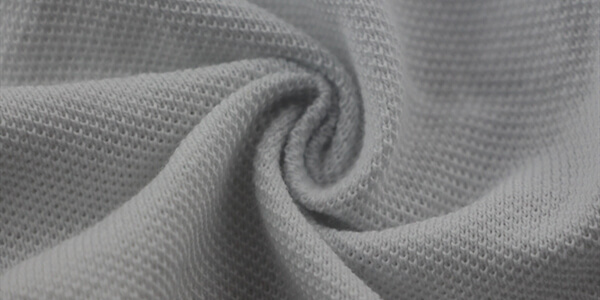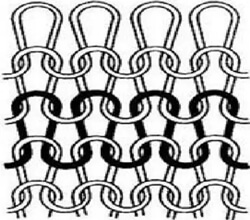
Erkundung der verschiedenen Stile von Stricktextilien
Stricken ist eine Form der Garnmanipulation, bei der Maschen miteinander vermascht werden, um Stoffe oder Textilien herzustellen. Diese Art von Gewebe besteht aus horizontalen Reihen, die als Reihen bekannt sind, und vertikalen Reihen, die als Maschenstäbchen bezeichnet werden. Gestrickte Stoffe werden in verschiedenen Alltagsgegenständen verwendet, von der Kleidung bis zur Bettwäsche.
Der Prozess des Strickens erfordert eine sorgfältige Manipulation von Garnschleifen. Um den Stoff zu erstellen, muss man aufeinanderfolgende Schleifen durch die Schleife einer vorherigen Reihe ziehen. Diese Zwischenwirkung bildet eine Reihe verbundener Schleifen, die das gestrickte Material erzeugen.
Strickstoffe sind berühmt für Kleidung, Decken und andere Gegenstände, die Wärme oder Flexibilität erfordern. Stricken ist nur eine Art von Stoffstruktur; Gewebte, nicht gewebte und geflochtene Stoffe sind ebenfalls Standard. Jedes hat ein ausgeprägtes Erscheinungsbild, Vor- und Nachteile. Die Art des Stoffes, die Sie auswählen, hängt davon ab, was Sie erstellen und das gewünschte Ergebnis. Wenn Sie die verschiedenen verfügbaren Materialformen kennen, können Sie eine fundierte Entscheidung treffen.
1. Gestrickte Stoffe
Gestrickte Stoffe bestehen normalerweise aus verschiedenen Rohmaterialien, wie Baumwollgarn, Mischgarn, Polyesterseide mit geringer Elastizität oder Polyesterseide mit besonderer Form, Nylonseide, Baumwollgarn, Wollgarn und Spandex-Seide. Diese Materialien werden unter Verwendung verschiedener Methoden gewebt, einschließlich der einfachen Maschenorganisation (enthaltend Grundstrick, wechselnde einfache Maschen, einfache Rippenbindung und doppelte Rippenbindung), Jacquard-Organisation und Wollkreisorganisation. Elastizität, Weichheit, Knitterfestigkeit und haarähnliche Textur sind Standardmerkmale von gestrickten Stoffen. Baumwollgestrick hat eine gute Feuchtigkeitsaufnahme und Luftdurchlässigkeit; das Material ist jedoch nicht knusprig und neigt zum Falten und Lockern. Auf der anderen Seite ist es wahrscheinlicher, dass Gestricke aus Chemiefasern Fusseln, Pilling oder Hakenseide bekommen.

Die Hauptkategorien von gestrickten Stoffen sind wie folgt:
Gewirke aus Polyester
Dieser Stoff passt zu Herren-, Frauen- und Kinderkleidung. Es ist ein sehr kräftiges resistentes und elastisches Material mit großer visueller Anziehungskraft. Es hat eine kompakte und dicke Struktur, die es ideal für Jacken, Anzüge, Sportbekleidung, Yoga -Kleidung, Kleidung im Freien, Windbreaker, Westen, Röcke und andere Kleidungsstücke ideal macht. Der Stoff verfügt über helle Farben und knackige Texturen, die den Tweed -Stilen von Wollstoff ähneln. Die Farbkoordination ist harmonisch und die Webdetails sind klar und unterschiedlich.
Gestrickter Baumwollstoff
Eine beliebte Wahl für viele Arten von Kleidung und Accessoires. Es findet sich in Kleidungsstücken wie T-Shirts, Unterwäsche, Freizeitkleidung, Jacken, Anzüge, Grabenmäntel und sogar Kinderkleidung. Diese Art von Stoff ist bekannt für seine glatte Textur und sein praller Gefühl. Es hat auch eine gute Elastizität und die Fähigkeit, Wärme zu halten. Zu den beliebten Arten von gestrickten Baumwollstoff gehören einfaches Stoff, Schweißtuch, mercerisierter Baumwoll, Kapuzenkleider, Luftschicht, römisches Tuch und doppelseitiges Tuch. Diese Stoffe sind von hervorragender Qualität und sind sie ideal für verschiedene Kleidungsstücke.
Baumwollgestrick mit Polyesterbezug
Der Stoff, der aus einer Polyester- und Baumwollmischung hergestellt wurde, eignet sich ideal für die Herstellung von Hemden, Jacken und Aktivkleidung. Die faltenbeständigen Fasern machen es unglaublich einfach zu versorgen, und seine kräftige resistente Zusammensetzung ermöglicht den lang anhaltenden Gebrauch. Es ist auch sehr atmungsaktiv und macht es bequem, wenn es an der Haut getragen wird. Darüber hinaus fällt es sich weich an, was es zu einer ausgezeichneten Wahl für Kleidungsstücke macht. Der Stoff ist auch in einer Reihe von Farben und Farbtönen gefärbt.
Stoffe aus recycelten Zellulosefasern
Sie sind eine beliebte Wahl für Kleidung und umfassen Tencel -Stoff, modaler Stoff, Bambusfasergewebe, Viskose -Stoff und Kupfer Ammoniakgewebe. Diese Stoffe sind weich, mit guten Wärme -Retentionseigenschaften und hohem Glanz. Strickkleidungsstücke wie T-Shirts, Unterwäsche, Leggings und Röcke werden oft aus diesen Stoffen hergestellt. Ihre leichten, aber dauerhaften Eigenschaften machen sie zu einer hervorragenden Option für den Alltag. In verschiedenen Materialien können Designer einzigartige Looks für jeden Stil oder Anlass entsprechen. Recycelte Zellulosefasergewebe können leicht gewaschen und gewartet werden, damit die Kleidungsstücke in den kommenden Jahren neu aussehen. Diese Stoffe können ein luxuriöses Erscheinungsbild mit der richtigen Sorgfalt verleihen. Sie sind auch umweltfreundlicher als traditionelle Stoffe, was sie zu einer immer beliebteren Wahl für modebewusste Verbraucher macht.
2.Warp Strickstoffe
Warp-gestrickte Stoffe werden im Allgemeinen aus synthetischen Filamentmaterialien wie Polyester, Nylon, Vinylon und Polypropylen hergestellt. Alternativ können sie mit natürlichen Fasern wie Baumwolle, Wolle, Seide oder Hanf konstruiert werden, die mit chemischen Fasern gemischt werden. Diese Art von Stoff bietet eine gute Längsstabilität, ein knackiges Gefühl und weniger Dispersion. Die Luftdurchlässigkeit ist ebenfalls gut, aber seine laterale Ausdehnung, Elastizität und Weichheit ist schwächer als Schussstoffe.
Warp-gestrichene Stoffe sind sehr langlebig und ideal für technische und medizinische Textilien, Schutzkleidung und Automobilgespräch. Warp -Stricken hat aufgrund ihrer einzigartigen Merkmale viele praktische Anwendungen in der Textilindustrie. Es wird häufig verwendet, um Dessous, Socken, dekorative Bänder, Zutaten, Badebekleidung und Polsterung herzustellen. Es wird auch als Verstärkung in Gummiprodukten wie Reifen und Schläuchen verwendet.
Warp -Stricken ist viel schneller als das Stricken des Schusss, da es nicht erfordert, das Garn in den gestrickten Stoff einzutreten. Dies bedeutet kürzere Produktionszeiten und Kosteneinsparungen für die Hersteller, was Warp-Stricken zu einer beliebten Wahl für die groß angelegte Produktion macht. Die Materialien können auch manipuliert werden, um komplexe Muster mit mehr Kontrolle als andere Arten des Strickens zu erzeugen. Warp -Strick ist in vielen Branchen wesentlich geworden, und technologische Fortschritte führen weiterhin zu neuen Möglichkeiten.
Die Hauptkategorien von Warp-Knittenstoffe sind wie folgt:
Polyester-Warp-gestation
Eine beliebte Auswahl für Bekleidung aufgrund seiner flachen Textur und leuchtenden Farben. Es kommt normalerweise in zwei Gewichten; dünn und dick. Leichte Polyester-Warp-Stoffe werden häufig zum Herstellen von Hemden und Röcken verwendet, während mittelgroße und dicke Materialien für andere Kleidungsstücke wie Jacken, Mäntel, Anzüge, Hosen und mehr verwendet werden können.
Warp -Stapelgewebe.
Dieser Stoff wird üblicherweise verwendet, um Winterkleidungsstücke wie Männer- und Frauenmäntel, Grabenmäntel, Jacken und Hosen zu produzieren. Es hat ein angenehmes Drapieren, ist leicht zu waschen, trocknet schnell und kann gebügelt werden. Es ist jedoch anfällig für statische Akkumulation und kann leicht Staub anziehen.
Wenn sie mit anderen Stoffen wie Wolle oder Acryl eingesetzt werden, nimmt das statische Eigentum zu und zieht mehr Staub an. Um dies zu verringern, können spezielle antistatische Oberflächen auf den Stoff angewendet werden. Dies schützt es vor Schmutz und Staub, wodurch das Material haltbarer und leichter zu reinigen wird.
Zusammenfassend ist ein Warp-Knitten-Stapelstoff ideal für Winterbekleidungen aufgrund seines überlegenen Drapens, des einfachen Waschens, des schnellen Trocknens und der Bügelfähigkeit. Es ist zu beachten, dass es anfällig für statische und Staubakkumulation ist und daher eine spezielle antistatische Veredelung oder andere Behandlungen erfordert, um dies zu verringern.
Warp-Knick-Maschen-Stoff
Netzstoff mit einer dünnen Textur und einer ausgezeichneten Elastizität verfügt über einen weichen, weichen Touch. Es bietet auch eine hervorragende Luftdurchlässigkeit, ideal für Sommerkleidung wie Herren- und Frauenhemden. Seine vielseitige Natur macht es zu einer beliebten Wahl unter Modedesigner und Verbrauchern.
Warp-Knittel-Samtgewebe
Die Oberfläche des mit Kette gestrichenen Samtstoffs ist dick und plüschig, was es unglaublich weich macht. Seine Elastizitäts- und Hitzeretentierungsfähigkeiten machen es zu einer idealen Wahl für Winterkleidung und Kinderbekleidung. Es ist ein luxuriöses Material, das Wärme, Komfort und Klasse bietet. Sein dicker Stapel verleiht jedem Kleidungsstück eine angenehme Textur. Daher wird es für seine Vielseitigkeit und Eleganz immer beliebter. Egal, ob Sie nach einem gemütlichen Wintermantel oder einem eleganten Partykleid suchen, dieser Stoff wird ein Statement abgeben. Seine üppige Textur und luxuriöses Gefühl machen es zur perfekten Wahl für jeden Anlass.
Warp Strick -Schleifengewebe.
Dieser Stoff hat dank seines soliden, aber geschmeidigen Stoffkörpers eine vollständige und dicke Konsistenz. Es ist elastisch, absorbiert Feuchtigkeit gut und sorgt für eine gute Wärme. Es zeichnet sich durch eine stabile Schleifenstruktur und eine überlegene Tragbarkeit aus und wird hauptsächlich für Sportbekleidung, Revers-T-Shirts, Pyjama und Kinderkleidung verwendet. Seine Vielseitigkeit macht es zu einer beliebten Wahl für viele Bekleidungsanwendungen.
Strickstoffe werden aus verschiedenen Materialien hergestellt, darunter Naturfasern wie Baumwolle, Hanf, Seide und Wolle sowie synthetische Fasern wie Acryl, Polyester und Spandex. Solche Stoffe bieten gute Elastizität, Feuchtigkeitsabsorption, Wärme und Komfort. Sie haben eine Vielzahl von Mustern, Farben und Texturen. Strickstoffe können nach Weben, Färben, Fertigstellen und anderen Verarbeitungsmethoden klassifiziert werden. Jede Art von Stoff hat seine einzigartigen Eigenschaften. Somit können Strickmaterialien für verschiedene Arten von Bekleidung für Männer, Frauen und Kinder verwendet werden.

